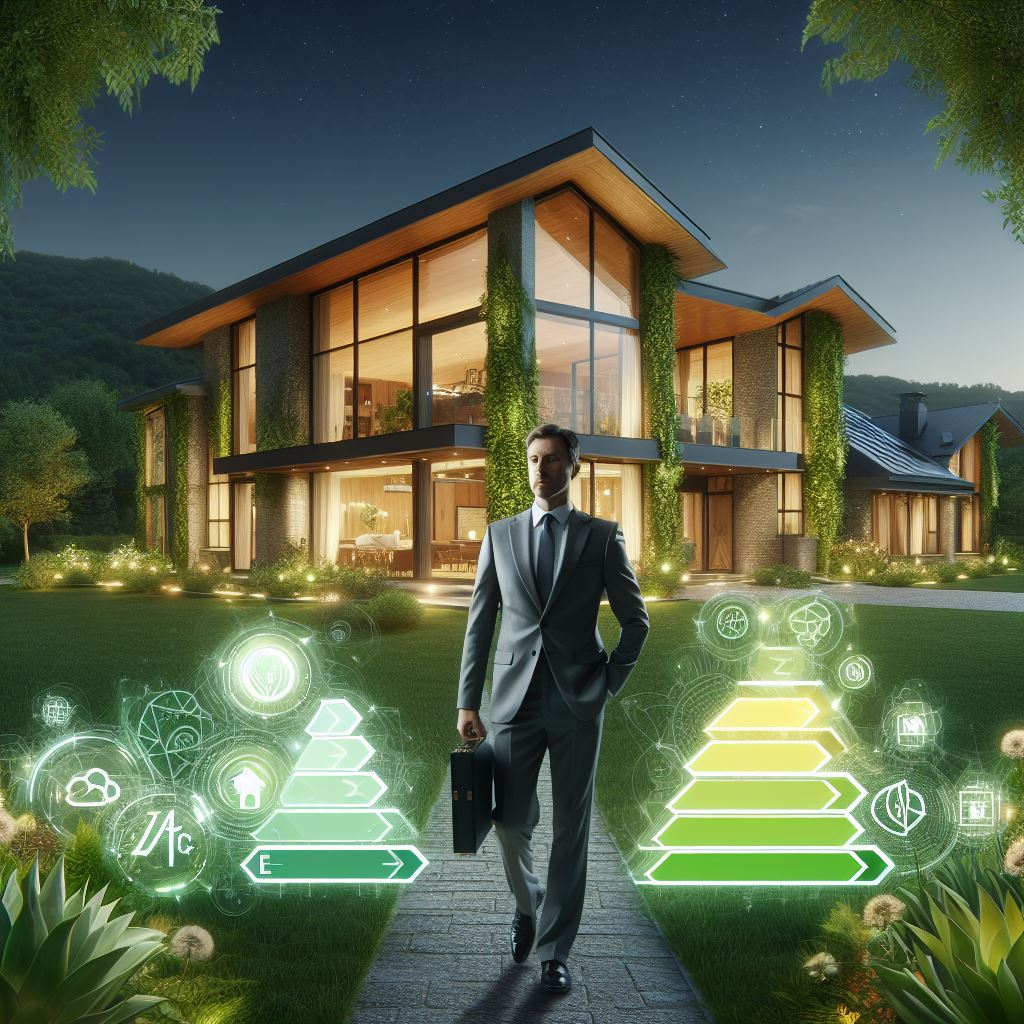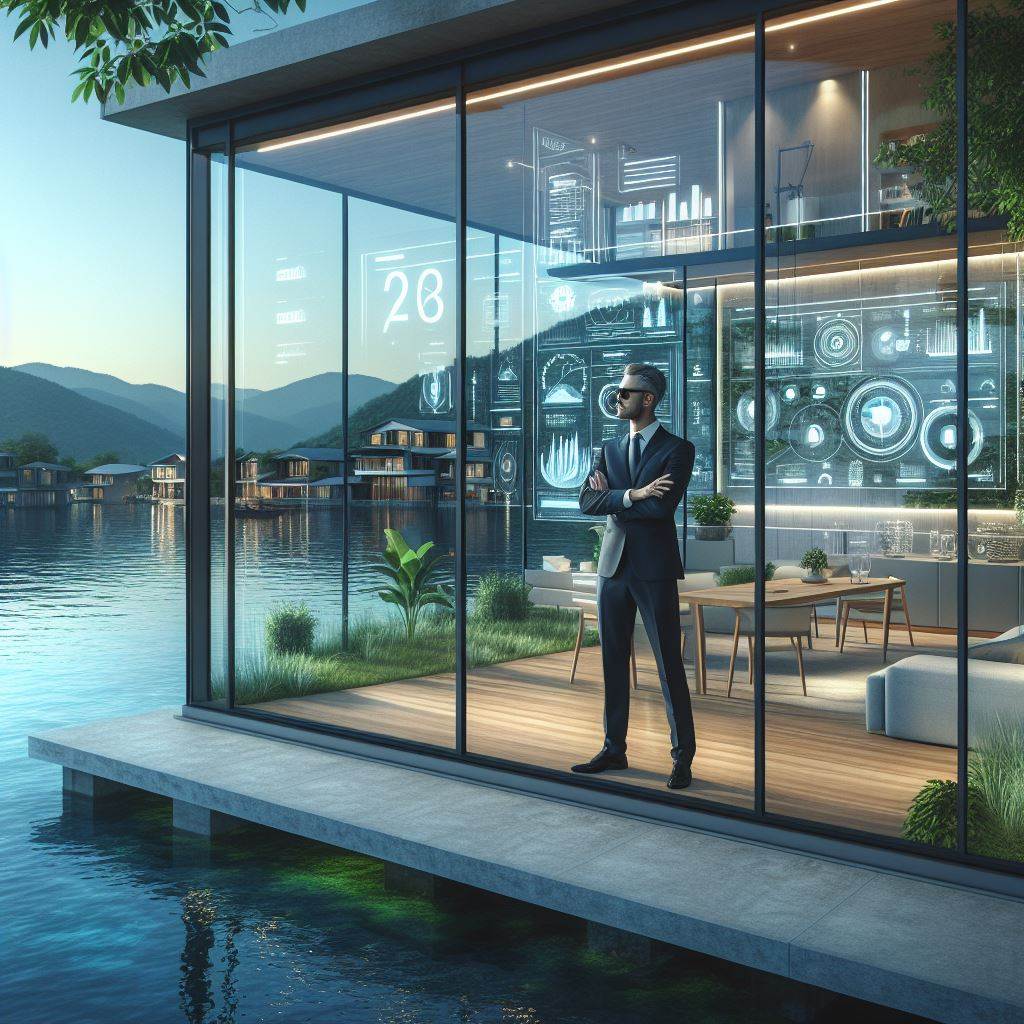Introduction
In the opulent realm of luxury real estate, a seismic shift is occurring, where eco-friendly trends are becoming not just a choice but a necessity.
With environmental consciousness at its zenith, the significance of these trends transcends mere aesthetics, delving into a realm where sustainability meets extravagance.
Consumers, once captivated solely by grandeur and lavishness, are now equally drawn to eco-friendly features in their dream homes.
This paradigm shift reflects an escalating demand for properties that seamlessly blend indulgence with environmental responsibility.
The allure of sustainable living is no longer confined to minimalist abodes; it has found its way into the echelons of luxury real estate.
As climate change and ecological concerns dominate global discourse, luxury homebuyers are channeling their aspirations towards residences that stand as paragons of green living.
These discerning individuals seek not just a place of residence, but a sanctuary that mirrors their commitment to a greener, healthier planet.
Developers and architects are responding to this evolving demand by integrating cutting-edge technologies and eco-friendly materials into their designs.
Solar panels, energy-efficient appliances, and green roofs are no longer exceptions but rather integral components of high-end residences.
This synergy between luxury and sustainability is reshaping the very fabric of the real estate landscape.
The rise of eco-friendly luxury real estate is more than a trend; it’s a testament to the evolving values of the modern elite.
As we delve into the world of opulent eco-living, it becomes apparent that the future of luxury real estate is not just about grandeur; it’s about responsibly curated magnificence.
In the subsequent sections, we will explore in detail how these trends are manifesting in architectural marvels, technological innovations, and the evolving expectations of luxury homebuyers.
Welcome to the era of Green Opulence!
Green Building Materials
The use of eco-friendly materials in luxury real estate construction
The use of eco-friendly materials in luxury real estate construction is gaining popularity.
Bamboo, reclaimed wood, and recycled metal are some sustainable materials used in luxury properties.
Using bamboo for flooring or furniture in luxury homes not only adds elegance but also reduces environmental impact.
Reclaimed wood from old structures can be repurposed for flooring, beams, or countertops, giving a rustic charm to luxury homes.
Recycled metal can be used for roofing or decorative elements, adding a unique and environmentally friendly touch to luxury real estate.
Luxury properties that incorporate green building materials are not only aesthetically pleasing but also promote sustainability.
For instance, a luxury beachfront villa features bamboo flooring, creating a seamless connection with the natural surroundings.
In another example, a luxury mountain retreat uses reclaimed wood for its beams and furniture, blending harmoniously with the landscape.
Benefits of sustainable materials such as bamboo, reclaimed wood, and recycled metal
The benefits of using sustainable materials in luxury real estate construction extend beyond environmental conservation.
Bamboo, for instance, is known for its durability, strength, and ability to regenerate quickly, making it an ideal choice for luxury homes.
Reclaimed wood adds character and historical value to luxury properties, creating a unique storytelling element.
Additionally, using recycled metal in luxury real estate reduces the demand for virgin materials and lowers carbon emissions.
Examples of luxury properties incorporating green building materials successfully
Green building materials also contribute to a healthier indoor environment for luxury homeowners.
Unlike conventional materials, eco-friendly alternatives do not contain harmful chemicals or volatile organic compounds (VOCs).
Luxury properties built using sustainable materials provide better air quality and promote overall well-being.
Apart from the use of green building materials, luxury real estate is adopting energy-efficient technologies.
Smart homes featuring energy-saving appliances, solar panels, and LED lighting are becoming increasingly popular.
These energy-efficient features not only reduce environmental impact but also lower utility bills for luxury homeowners.
Luxury properties incorporating sustainable materials and energy-efficient technologies promote a greener and more luxurious lifestyle.
Investing in eco-friendly luxury real estate ensures not only a beautiful and comfortable living space but also a sustainable future.
In fact, the use of eco-friendly materials in luxury real estate construction is a growing trend.
Bamboo, reclaimed wood, and recycled metal are examples of sustainable materials that offer numerous benefits.
Luxury properties that successfully incorporate green building materials create aesthetically appealing spaces while promoting sustainability.
Additionally, energy-efficient technologies are being adopted in luxury homes, further contributing to a greener and more luxurious lifestyle.
Investing in eco-friendly luxury real estate ensures not only a beautiful living space but also a sustainable future.
Read: Smart Tips for First-Time Luxury Investors
Energy-Efficient Designs
The importance of energy-efficient designs in luxury real estate cannot be overstated.
With increasing concerns about climate change and rising energy costs, homeowners are now prioritizing sustainable and eco-friendly features in their dream homes.
Solar Panels
One of the most popular energy-efficient features in luxury homes is solar panels.
These panels convert sunlight into electricity, reducing reliance on traditional energy sources and lowering utility bills.
Not only do solar panels help homeowners save money, but they also significantly reduce carbon emissions.
Geothermal Heating and Cooling Systems
Luxury homes are now incorporating geothermal heating and cooling systems, which utilize the earth’s natural heat to warm and cool living spaces.
These systems are highly energy-efficient and can reduce energy consumption by up to 70%.
By harnessing the earth’s renewable energy, homeowners can enjoy a comfortable living environment while minimizing their carbon footprint.
Smart Home Technology
Smart home technology allows homeowners to control and optimize energy usage seamlessly.
These systems enable residents to remotely control lighting, heating, cooling, and other appliances, resulting in substantial energy savings.
For example, advanced thermostats can adjust temperature settings based on occupancy patterns, leading to significant reductions in energy waste.
Examples of Effective Energy-Efficient Designs
Several luxury homes around the world have successfully implemented energy-efficient designs.
One notable example is the Mauna Lani Resort in Hawaii, which features solar panels, rainwater harvesting systems, and greywater recycling.
The resort’s eco-friendly initiatives have earned it LEED Platinum certification and reduced energy consumption by 50%.
Another exemplary case is SkyRose Chapel in California, designed with a focus on energy efficiency and sustainability.
The chapel includes solar panels, radiant floor heating, and natural ventilation systems, reducing its reliance on traditional energy sources.
It has been recognized as a Net Zero Energy building, producing as much energy as it consumes.
In summary, energy-efficient designs have become increasingly important in luxury real estate due to the growing urgency to combat climate change and reduce energy consumption.
Features such as solar panels, geothermal heating and cooling systems, and smart home technology enable homeowners to live in luxurious comfort while minimizing their environmental impact.
With innovative examples like the Mauna Lani Resort and SkyRose Chapel, it is evident that luxury homes can integrate energy-efficient designs effectively.
Read: Oceanfront vs. Lakefront: Luxury Property Duel
Sustainable Landscaping
The growing trend of eco-friendly landscaping in luxury real estate
The trend of eco-friendly landscaping is gaining traction in luxury real estate.
Property owners are increasingly focusing on creating sustainable landscapes that are not only visually appealing but also environmentally responsible.
One of the key principles of sustainable landscaping is the use of native plants.
These are plants that are naturally adapted to the local climate, soil conditions, and rainfall patterns.
By incorporating native plants, luxury properties can reduce the need for excessive watering and fertilization, as these plants are already well-suited to thrive in their surroundings.
Another aspect of sustainable landscaping is the implementation of rainwater harvesting systems.
Instead of relying solely on municipal water sources, luxury properties are now equipped with systems that collect and store rainwater for irrigation purposes.
This not only helps conserve water but also reduces the strain on local water supplies.
Organic gardening practices are also gaining popularity in eco-friendly luxury real estate.
Property owners are prioritizing the use of organic fertilizers, pesticides, and herbicides to maintain their landscapes.
This reduces the release of harmful chemicals into the environment and promotes the health of plants, soil, and local wildlife.
Examples of luxury properties showcasing sustainable landscaping techniques
Several luxury properties serve as excellent examples of sustainable landscaping techniques.
For instance, the Hampton Haven features a beautifully landscaped garden with a variety of native plants.
The property also has a rainwater harvesting system that provides water for the irrigation of its expansive lawns and flowerbeds.
In addition, the Malibu Manor showcases an organic garden where a wide range of fruits and vegetables are grown using only organic practices.
The property’s landscaping not only contributes to a healthier environment but also provides fresh and sustainable produce for the owners and their guests.
By embracing sustainable landscaping practices, luxury real estate owners not only enhance the aesthetic appeal of their properties but also contribute to the conservation of natural resources.
They demonstrate a commitment to eco-friendly living, which is increasingly valued by discerning buyers.
As the trend of eco-friendly luxury real estate continues to grow, sustainable landscaping is set to play a significant role.
Property owners are recognizing the importance of creating environmentally responsible landscapes that are in harmony with their surroundings.
By incorporating native plants, rainwater harvesting systems, and organic gardening practices, luxury properties can lead the way in embracing eco-friendly trends in the industry.
Read: The Risks of Luxury Real Estate Investing

Water Conservation
Importance of water conservation in luxury real estate
Water conservation is of utmost importance in luxury real estate, as it not only helps preserve a precious resource but also reflects a commitment towards sustainability.
Luxury homeowners are increasingly incorporating various features and practices to reduce water consumption in their properties.
Features such as low-flow fixtures, greywater recycling systems, and drought-resistant landscaping
When it comes to water conservation, one effective strategy is the use of low-flow fixtures.
These fixtures, such as faucets, showerheads, and toilets, are designed to limit water flow without compromising performance.
They help save thousands of gallons of water every year while maintaining the luxurious experience homeowners desire.
Another popular water conservation feature is the implementation of greywater recycling systems.
Greywater refers to water that has been used in sinks, showers, and laundry, but is still relatively clean and can be reused for irrigation or toilet flushing.
Luxury homes with greywater systems can significantly reduce their reliance on freshwater sources and contribute to sustainable water management.
Examples of luxury homes demonstrating effective water conservation practices
In addition to low-flow fixtures and greywater recycling, drought-resistant landscaping plays a significant role in water conservation.
These types of landscaping designs utilize native plants and flowers that are adapted to regional climate conditions and require minimal irrigation.
By reducing or eliminating the need for excess watering, luxury homeowners can conserve water without compromising the aesthetic appeal of their landscapes.
Many luxury homes around the world serve as examples of effective water conservation practices.
For instance, Villa La Cascade in Los Angeles is equipped with a state-of-the-art greywater recycling system, reducing the property’s overall water consumption by half.
Similarly, the Oceanscape villa in Costa Rica utilizes low-flow fixtures throughout its luxury bathrooms, kitchens, and outdoor spaces, resulting in significant water savings.
In summary, water conservation is a crucial aspect of eco-friendly trends in luxury real estate.
Through the incorporation of low-flow fixtures, greywater recycling systems, and drought-resistant landscaping, luxury homeowners can minimize water consumption while maintaining the high standards and luxurious experience they desire.
By embracing these sustainable practices, luxury real estate can make a positive impact on the environment and inspire others to prioritize water conservation as well.
Read: Top 10 U.S. Luxury Waterfront Homes in 2024
Health and Well-being Benefits
When it comes to luxury real estate, incorporating eco-friendly features goes beyond just being environmentally conscious.
These features also contribute significantly to the health and well-being of the occupants.
Eco-friendly Features and Health
Eco-friendly luxury real estate embraces elements that promote a healthy lifestyle.
From the construction stage to the final design, developers prioritize the use of materials and practices that prioritize the well-being of the occupants.
For instance, the use of non-toxic materials in construction ensures that the air quality indoors remains pristine.
Traditional materials often contain harmful chemicals such as formaldehyde, which can lead to respiratory issues and allergies.
By opting for non-toxic alternatives, luxury real estate developers eliminate these health hazards.
Additionally, eco-friendly luxury homes incorporate indoor air quality systems.
These systems work to remove pollutants and enhance the quality of the air within the space.
This feature is particularly beneficial for individuals with respiratory conditions or allergies, as their symptoms are reduced in a cleaner environment.
Natural Lighting and Well-being
Natural lighting plays a crucial role in the overall well-being of individuals.
Luxury real estate that emphasizes eco-friendly design principles seeks to maximize the use of natural light throughout the property.
With ample access to natural light, occupants experience an array of benefits.
One study found that natural light exposure can improve mood, productivity, and sleep quality.
It also reduces eye strain and can benefit individuals with seasonal affective disorder (SAD).
Incorporating larger windows, skylights, and open floor plans allows for optimal natural light penetration, ensuring a healthy and vibrant indoor environment.
Research Supporting Eco-friendly Living
Multiple studies and research have been conducted to support the positive impacts of eco-friendly living on the health and well-being of occupants.
A study published in the Journal of Exposure Science & Environmental Epidemiology revealed that individuals living in green-certified buildings reported fewer sick days, better sleep quality, and increased overall satisfaction with their health and well-being.
Another study conducted by the University of Notre Dame found that green-certified buildings have a positive impact on cognitive function.
Participants showed higher cognitive scores in green environments compared to conventional environments.
Furthermore, research conducted by the University of Essex showed that exercise in natural environments has greater benefits for mental well-being than exercise indoors or in urban environments.
All these studies provide strong evidence that eco-friendly features in luxury real estate have a significant positive impact on the health and well-being of occupants.
In a nutshell, eco-friendly trends in luxury real estate have proven to be more than just a way to reduce environmental impact.
The incorporation of non-toxic materials, indoor air quality systems, and natural lighting contribute to the health and well-being of occupants.
Research and studies support these benefits, emphasizing the importance of eco-friendly living for a healthier lifestyle.
Conclusion
Eco-friendly trends in luxury real estate play a crucial role in the industry.
The demand for sustainable and environmentally-conscious properties is continuously growing.
People are increasingly mindful of the impact their lifestyle has on the planet.
As a result, eco-friendly features and designs are becoming essential selling points for luxury homes.
From energy-efficient appliances to smart home technology and eco-friendly building materials, these features enhance the value and appeal of a property.
The future of eco-friendly luxury real estate looks promising, as more developers and buyers embrace sustainable practices.
The industry is also witnessing advancements in green building techniques and renewable energy solutions.
As awareness and concern for the environment increase, the demand for eco-friendly luxury homes will continue to rise.
With sustainable living being a top priority, the focus on eco-friendly trends will only intensify in the years to come.
As the market evolves, the integration of sustainable practices will become the norm in luxury real estate.
Ultimately, eco-friendly luxury real estate presents an exciting and positive future that aligns with the growing desire for a more sustainable and environmentally-conscious lifestyle.




